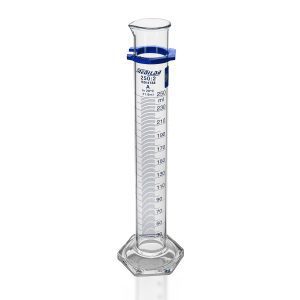Volumetric Glassware
Showing all 33 results
-

Burette Rods
SKU: 11251
Read more -

Burette with Glass Stopcock
SKU: 11252A
Read more -

Burette with Glass Stopcock, Class B
SKU: 11252B
Read more -

Burette, with Screw Type Rotaflow Stopcock
SKU: 11253A
Read more -

Burette, with Screw Type Rotaflow Stopcock, Class B
SKU: 11253B
Read more -

Burette, with Straight Bore PTFE Key Stopcock, Class A
SKU: 11254A
Read more -

Burette with Straight Bore PTFE Key Stopcock, Class B
SKU: 11254B
Read more -

Burette, with straight bore PTFE key stopcock, Schellbach, Class A
SKU: 11255A
Read more -

Burette, with straight bore PTFE key stopcock, Schellbach, Class B
SKU: 11255B
Read more -

Burette Automatic Zero, Class A
SKU: 11256A
Read more -

Burette, Automatic Zero, Amber Glass, Class A
SKU: 11256AA
Read more -

Burette Automatic Zero, Class B
SKU: 11256B
Read more -

Pipette, Volumetric, One Mark, Class-AS
SKU: 11257A
Read more -

Pipette, Volumetric, One Mark, Class-B
SKU: 11257B
Read more -

Pipette, Graduated, Mohr Type, Class ‘AS’
SKU: 11258A
Read more -

Pipette, Graduated, Mohr Type, Class ‘B’
SKU: 11258B
Read more -

Pipette, Graduated, Serological Type, Class ‘A’
SKU: 11259A
Read more -

Pipette, Graduated, Serological Type, Class ‘B’
SKU: 11259B
Read more -

Volumetric Flask, with Glass Stopper, Class ‘A’
SKU: 11260.1A
Read more -

Amber Volumetric Flask Glass PP Stopper, Class ‘A’
SKU: 11260.2AA
Read more -

Volumetric Flask, with PP Stopper, Class ‘A’
SKU: 11260A
Read more -

Volumetric Flask, with PP Stopper, Class ‘B’
SKU: 11260B
Read more -

Measuring Cylinder with PE Base, Class A
SKU: 11261
Read more -

Measuring Cylinder, with Spout and Round Base, Class A
SKU: 11262A
Read more -

Measuring Cylinder, with Spout and Round Base, Class B
SKU: 11262B
Read more -

Measuring Cylinder, with screw cap, Class A
SKU: 11263.1
Read more -

Mixing Cylinder, with PP Stopper, Round Base, Class-A
SKU: 11263A
Read more -

Mixing Cylinder, with PP Stopper, Round Base, Class-B
SKU: 11263B
Read more -

Measuring Cylinder, with Hexagonal Base, Class ‘A’
SKU: 11264A
Read more -

Measuring Cylinder, with Hexagonal Base, Class ‘B’
SKU: 11264B
Read more -

Nessler Cylinder, Class ‘A’
SKU: 11265A
Read more -

Nessler Cylinder, Class ‘B’
SKU: 11265B
Read more -

Amber Lab Glassware
SKU: 11267
Read more


